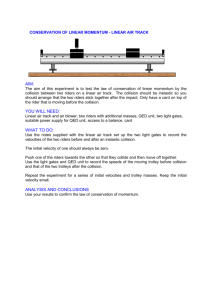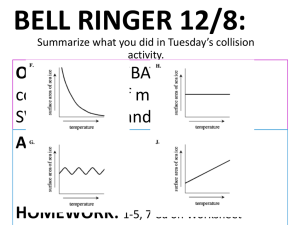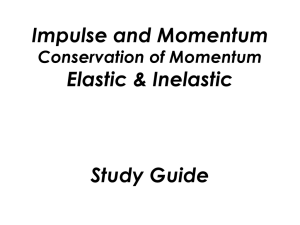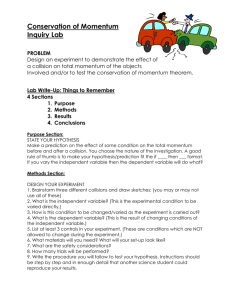Collisions and Momentum Internet Lab
advertisement
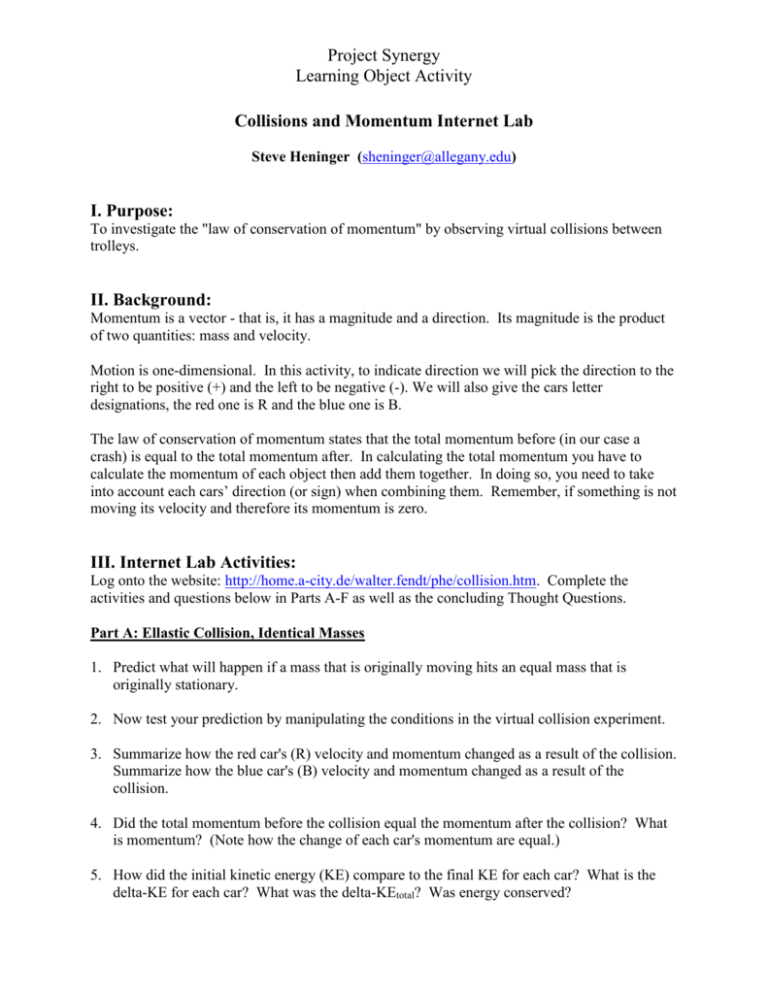
Project Synergy Learning Object Activity Collisions and Momentum Internet Lab Steve Heninger (sheninger@allegany.edu) I. Purpose: To investigate the "law of conservation of momentum" by observing virtual collisions between trolleys. II. Background: Momentum is a vector - that is, it has a magnitude and a direction. Its magnitude is the product of two quantities: mass and velocity. Motion is one-dimensional. In this activity, to indicate direction we will pick the direction to the right to be positive (+) and the left to be negative (-). We will also give the cars letter designations, the red one is R and the blue one is B. The law of conservation of momentum states that the total momentum before (in our case a crash) is equal to the total momentum after. In calculating the total momentum you have to calculate the momentum of each object then add them together. In doing so, you need to take into account each cars’ direction (or sign) when combining them. Remember, if something is not moving its velocity and therefore its momentum is zero. III. Internet Lab Activities: Log onto the website: http://home.a-city.de/walter.fendt/phe/collision.htm. Complete the activities and questions below in Parts A-F as well as the concluding Thought Questions. Part A: Ellastic Collision, Identical Masses 1. Predict what will happen if a mass that is originally moving hits an equal mass that is originally stationary. 2. Now test your prediction by manipulating the conditions in the virtual collision experiment. 3. Summarize how the red car's (R) velocity and momentum changed as a result of the collision. Summarize how the blue car's (B) velocity and momentum changed as a result of the collision. 4. Did the total momentum before the collision equal the momentum after the collision? What is momentum? (Note how the change of each car's momentum are equal.) 5. How did the initial kinetic energy (KE) compare to the final KE for each car? What is the delta-KE for each car? What was the delta-KEtotal? Was energy conserved? Project Synergy Learning Object Activity Part B: Inelastic Collision, Identical Masses 1. A totally inelastic collision occurs when the masses stick together after the collision. Predict what will happen if a car that is originally moving hits and sticks to a car that is originally stationary. 2. Now test your prediction by manipulating the conditions in the virtual collision experiment. 3. Summarize how the red car's (R) velocity and momentum changed as a result of the collision, and indicate the car’s delta-KE. Summarize how the blue car's (B) velocity and momentum changed as a result of the collision, and indicate the car’s delta-KE. Part C: Inelastic Collision, Different Masses 1. Predict what will happen if a smaller mass that is originally moving hits and sticks to a larger mass that is originally stationary. Include in your predication how this may differ from the results obtained in the Part B collisions. 2. Test your prediction by manipulating the conditions in the virtual collision experiment. What happens in this collision? Do the results confirm or disprove your prediction? Explain your answers. 3. Now reverse the roles of the small and large trolleys (i.e. the small trolley should originally be stationary and the large trolley should originally be moving), and predict what will happen in this collision. Include in your predication how this may differ from the results obtained in the Part B collisions, as well as how this may differ from the results obtained in Part C Steps 1-2. 4. Test your prediction by manipulating the conditions in the virtual collision experiment. What happens in this collision? Do the results confirm or disprove your prediction? Explain your answers. Part D: Elastic Collision, Different Masses 1. Predict what will happen if a car that is originally moving hits a heavier car that is originally stationary. 2. Test your prediction by manipulating the conditions in the virtual collision experiment. What happens in this collision? Does this confirm or disprove your prediction? Explain your answers. Project Synergy Learning Object Activity 3. Now reverse the roles and predict what will happen in a collision in which the heavier mass is moving and the lighter mass is initially stationary. 4. Test your prediction by manipulating the conditions in the virtual collision experiment. What happens in this collision? Does this confirm or disprove your prediction? Explain your answers. Part E: Collision In Which Both Trolley Are Moving Simulate and then describe two collisions from each sub-category below (that's a total of 8 collisions): 1) Two Cars of Identical Mass a) elastic collision b) inelastic collision 2) Two Cars of Differing Mass a) elastic collision b) inelastic collision For each collision be sure to: a) indicate the relative magnitudes of velocities before and after the collision, and b) make before and after sketches using arrows to show speed and directions of the two trolleys. Note in this section that you do not need numerical answers, rather just which car is faster or slower, did a trolley speed up or slow down due to a collision, and did its direction change? Part F: Other Collisions Are there other collisions you wish to investigate? If so, then: 1) Describe the starting conditions. 2) Predict what will happen in this collision. 5. Test your prediction by manipulating the conditions in the virtual collision experiment. 6. What happens in this collision? Does this confirm or disprove your prediction? Explain your answers. Thought Questions: 1. How was the collision in Part A different from Part B? Project Synergy Learning Object Activity 2. Write a paragraph in which you describe what was conserved and what was not conserved in both elastic and inelastic collisions. Also explain what happened to the kinetic energy in inelastic collisions. 3. What are your conclusions about collisions that involve cars of the same size as compared to cars of differing sizes? 4. Will a head-on collision between two cars be more damaging to the occupants if the cars stick together upon impact or if they rebound? Explain your answer. (Note that in car accidents humans get injured by their impact with the interior of the car. That impact is equal to the car's (and human's) change of momentum.)
